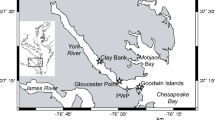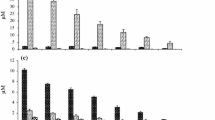Abstract
Nitrogen regeneration accompanying the bacterial degradation of a variety of amino acids supplied at 10.0 μM to samples of coastal plankton communities collected near Halifax, Nova Scotia, Canada was examined. A lag period characterized by a low rate of amino acid uptake and ammonia release was typically followed by a dramatic increase in the rates of uptake and ammonia release. The duration of the lag period varied with the amino acid tested. The ratio of the final ammonia concentration to the nitrogen supplied as amino acid was taken as the regeneration ratio. This value varied from 0.58 to 0.86 for L-arginine and 0.38 to 1.17 for the other amino acids tested, with an average value of 0.74. The presence of inorganic fixed nitrogen at 10.0 μM had no effect on the degradation of L-arginine. Other organic compounds supplied at 10.0 μM decreased the lag period for L-arginine uptake and degradation. Glucose supplied at 50.0 μM decreased the nitrogen regeneration ratio, but did not further decrease the lag for L-arginine degradation. Carbon respiration ratios for L-arginine, L-glutamate, and L-lysine were 0.70, 0.68, and 0.65 when the nitrogen regeneration ratios were 0.86, 0.38, and 0.77, respectively.
Similar content being viewed by others
Literature Cited
Carpenter, E.J., C.C. Remsen, and S.W. Watson: Utilization of urea by some marine phytoplankters. Limnol. Oceanogr. 17, 265–269 (1972)
Cowey, C.B. and E.D.S. Corner: On the nutrition and metabolism of zooplankton. I. Amino acids and some other nitrogenous compounds in Calanus finmarchicus. J. mar. biol. Ass. U.K. 43, 485–493 (1963a)
——: On the nutrition and metabolism of zooplankton. II. The relationship between the marine copepod Calanus helgolandicus and particulate material in Plymouth seawater in terms of amino acid compositions. J. mar. biol. Ass. U.K. 43, 495–511 (1963b)
Crawford, C.C., J.E. Hobbie and K.L. Webb: Utilization of dissolved free amino acids by estuarine microorganisms. Ecology 55, 551–563 (1974)
Gocke, K.: Respiration von gelösten organischen Verbindungen durch natürliche Mikroorganismen-Populationen. Ein Vergleich zwischen verschiedenen Biotopen. Mar. Biol. 35, 375–383 (1976)
Guillard, R.R.L. and J.H. Ryther: Studies on marine plankton diatoms. I. Cyclotella nana Hustedt and Detonula confervacea (Cleve). Gran. Can. J. Microbiol. 8, 229–239 (1962)
Hamilton, R.D. and K.E. Austin: Assay of relative heterotrophic potential in the sea: the use of specifically labelled glucose. Can. J. Microbiol. 13, 1165–1173 (1967)
— and J.E. Preslan: Observations on heterotrophic activity in the eastern tropical Pacific. Limnol. Oceanogr. 15, 395–401 (1970)
Hobbie, J.E. and C.C. Crawford: Respiration corrections for bacterial uptake of dissolved organic compounds in natural waters. Limnol. Oceanogr. 14, 528–532 (1969)
——, and K.L. Webb: Amino acid flux in an estuary. Science, N.Y. 159, 1453–1464 (1968)
Hollibaugh, J.T.: The biological degradation of arginine and glutamic acid in seawater in relation to the growth of phytoplankton. Mar. Biol. 36, 303–312 (1976a)
Hollibaugh, J.T.: Nitrogen regeneration during amino acid degradation and the activity of bacteria in plankton communities of Halifax Harbour, Nova Scotia, Canada, 196 pp. Ph.D. Thesis, Department of Oceanography, Dalhousie University 1976b
Jannasch, H.W.: Steady state and the chemostat in ecology. Limnol. Oceanogr. 19, 716–720 (1974)
— and R.I. Mateles: Experimental bacterial ecology studied in continuous culture. Adv. microb. Physiol. 11, 165–212 (1974)
Jeffries, H.P.: Seasonal composition of temperate plankton communities: free amino acids. Limnol. Oceanogr. 14, 41–52 (1969)
McCarthy, J.J.: The uptake of urea by natural populations of marine phytoplankton. Limnol. Oceanogr. 17, 738–748 (1972)
Mitamura, O. and P. Saijo: Decomposition of urea associated with photosynthesis of plankton in coastal waters. Mar. Biol. 30, 67–72 (1975)
North, B.B.: Primary amines in California coastal waters: utilization by phytoplankton. Limnol. Oceanogr. 20, 20–27 (1975)
Parsons, T.R., K. Stephens and J.D.M. Strickland: On the chemical composition of eleven species of phytoplankters. J. Fish. Res. Bd Can. 18, 1001–1015 (1961)
— and N. Takahashi: Biological oceanographic processes, 186 pp. Toronto: Pergamon Press 1973
Pocklington, R.: Free amino acids dissolved in North Atlantic ocean waters. Nature, Lond. 230, 374–375 (1971)
Seki, H., T. Nakai and H. Otobe: Regional differences on turnover rate of dissolved materials in the Pacific Ocean at summer 1971. Arch. Hydrobiol. 71, 79–89 (1972)
Solórzano, L.: Determination of ammonia in natural waters by the phenolhypochlorite method. Limnol. Oceanogr. 14, 799–801 (1969)
Stumm-Zollinger, E. and R.H. Harris: Kinetics of biologically mediated oxidation of organic compounds in receiving waters and in waste treatment. In: Organic compounds in aquatic environments, pp 555–598. Ed. by S.J. Faust and J.V. Hunter. New York: Dekker 1971
Thayer, G.W.: Identity and regulation of nutrients limiting phytoplankton production in the shallow estuaries near Beaufort, N.C. Oecologia (Berl.) 14, 75–92 (1974)
Thompson, B. and R.D. Hamilton: Heterotrophic utilization of sucrose in an artificially enriched lake. J. Fish. Res. Bd Can. 30, 1547–1552 (1973)
——: Some problems with heterotrophic-uptake methodology. In: Effects of the ocean environment on microbial activities, pp 566–575. Ed. by R.R. Colwell and R.Y. Morita. Baltimore: University Park Press 1974
Vaccaro, R.F.: The response of natural microbial populations in seawater to organic enrichment. Limnol. Oceanogr. 14, 726–735 (1969)
— and H.W. Jannasch: Studies on heterotrophic activity in seawater based on glucose assimilation. Limnol. Oceanogr. 11, 596–607 (1966)
——: Variations in uptake kinetics for glucose by natural populations in seawater. Limnol. Oceanogr. 12, 540–542 (1967)
Wang, C.H., I. Stern, C.M. Gilmour, S. Klungsoyr, D.J. Reed, J.J. Bialy, B.E. Christensen and V.H. Cheldelin: Comparative study of glucose metabolism by the radiorespirometric method. J. Bact. 76, 207–216 (1958)
Williams, P.J. LeB: Heterotrophic utilization of dissolved organic compounds in the sea. I. Size distribution of population and relationship between respiration and incorporation of growth substrates. J. mar. biol. Ass. U.K. 50, 859–870 (1970)
—: The validity of the application of simple kinetic analysis to heterogenous microbial populations. Limnol. Oceanogr. 18, 159–165 (1973a)
—: On the question of growth yields of natural heterotrophic populations. Bull. ecol. Res. Comm. Stockholm 17, 400–401 (1973b)
— and C. Askew: A method of measuring the mineralization by microorganisms of organic compounds in seawater. Deep-Sea Res. 15, 365–375 (1968)
—, T. Berman and O. Holm Hansen: Amino acid uptake and respiration by marine heterotrophs. Mar. Biol. 35, 41–47 (1976)
— and R.W. Gray: Heterotrophic utilization of dissolved organic compounds in the sea. II. Observations on the responses of heterotrophic marine populations to abrupt increases in amino acid concentration. J. mar. biol. Ass. U.K. 51, 871–881 (1970)
— and C.S. Yentsch: An examination of photosynthetic production, excretion of photosynthetic products, and heterotrophic utilization of dissolved organic compounds with reference to results from a coastal subtropical sea. Mar. Biol. 35, 31–40 (1976)
Wright, R.T.: Mineralization of organic solutes by heterotrophic bacteria. In: Effect of the ocean environment on microbial activities, pp 546–565. Ed. by R.R. Colwell and R.Y. Morita. Baltimore: University Park Press 1974
— and J.E. Hobbie: The uptake of organic solutes in lake water. Limnol. Oceanogr. 10, 22–28 (1965)
——: Use of glucose and acetate by bacteria and algae in aquatic ecosystems. Ecology 47, 447–464 (1966)
Author information
Authors and Affiliations
Additional information
Communicated by T.R. Parsons, Vancouver
Rights and permissions
About this article
Cite this article
Hollibaugh, J.T. Nitrogen regeneration during the degradation of several amino acids by plankton communities collected near Halifax, Nova Scotia, Canada. Mar. Biol. 45, 191–201 (1978). https://doi.org/10.1007/BF00390601
Accepted:
Issue Date:
DOI: https://doi.org/10.1007/BF00390601




